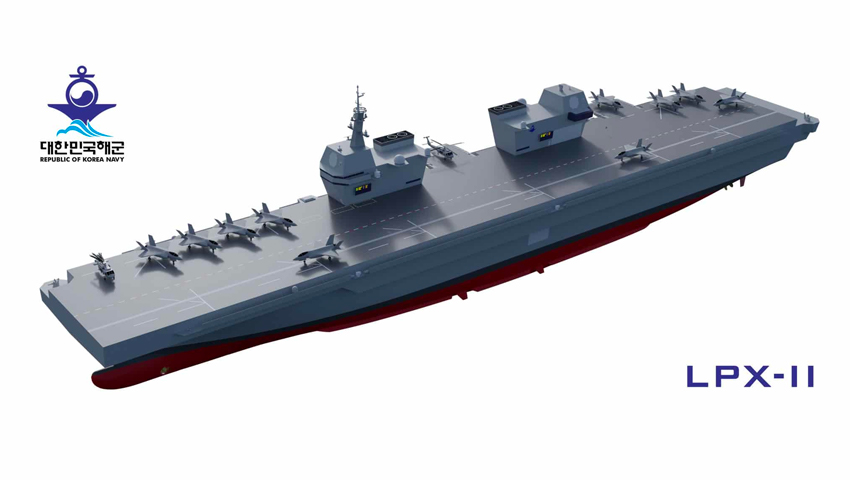The Republic of Korea Navy (ROK-N) has officially confirmed the launch of the LPX-II aircraft carrier program, finalising the design details and budget formally allocated as part of the 2020-2024 Mid-term Defense Plan.
To continue reading the rest of this article, please log in.
Create free account to get unlimited news articles and more!
As both China and Japan surge ahead with plans to build potent aircraft carrier capabilities, South Korea has joined the race and announced plans to build a modified large-deck aircraft carrier based on the Republic of Korea Navy (ROKN) Dokdo class amphibious warfare ships.
In recent years, nations throughout the Indo-Pacific have begun a series of naval expansion and modernisation programs with traditional aircraft carriers and large-deck, amphibious warfare ships serving as the core of their respective shift towards greater maritime power projection.
Driving this change is an unprecedented period of Chinese assertiveness in the South China Sea and the growing capabilities of the People's Liberation Army Navy (PLAN), which has seen the Chinese fielding or preparing to field a range of power projection capabilities, including aircraft carriers and supporting strike groups, fifth-generation combat aircraft, modernised land forces, area-access denial and strategic nuclear forces, combined with growing political and financial influence throughout the region.
Building on this, the long-term threat from North Korea has prompted South Korea to embark on a series of land, air and sea acquisition programs that support the Republic of Korea's transition towards developing a robust, deployable, conventional power projection and deterrence focused force – the first stage of this redevelopment is the planned construction of a 30,000-ton short-take off, vertical landing (STOVL) aircraft carrier.
However, further developments, including recent submarine-launched ballistic missile tests by North Korea, combined with the growing capabilities of the PLAN following the recent sea trials for the fleet's second short-take off, barrier arrested landing (STOBAR) aircraft carrier and the launch of its first large-deck amphibious warfare ship, has spurred a South Korean response.
The first of South Korea's aircraft carriers is an enlarged variant of the currently in service, Dokdo class landing platform dock ships, which are more akin to Australia's Canberra Class LHDs and the US Navy's Wasp and America class LHDs.
Construction of the LPX-II Class is expected to commence in 2021 by Hyundai Heavy Industries (HHI) for launch later in the 2020s – the proposed vessel is expected to be longer and heavier than the Dokdo class vessels with a displacement of approximately 30,000 tons and capable of accommodating 20 F-35Bs and an unspecified number of helicopters.
Unlike the preceding Dokdo class vessels, the LPX-II will not include a well dock, enabling the ship to carry more fuel and munitions to support the sustained fixed-wing naval aviation operations against heavily defended airspace or naval formations.
The South Korean Ministry for National Defense stated, "The 30,000-ton level aircraft carrier can transport military forces, equipment and materials and can operate fighter jets that are capable of vertical take-off and landing.
"It will enable the military to more effectively suppress threats and dispatch forces and materials to a disputed region in the sea by playing a role of a controlling vessel for the Navy unit."
The South Korean vessel draws on design elements from both the UK Royal Navy's Queen Elizabeth class aircraft carriers, with dual island towers and a distinct lack of launch ramp-like US Navy big deck amphibious warfare ships.
This progress builds on the ongoing regional carrier race and serves as a key component of the South Korean government's shifting strategic doctrine which places increasing importance on sustainable, blue water-focused, power projection to secure the nation's access to sea lines of communication.
Former US Navy captain and a former director of operations at the US Pacific Command's Joint Intelligence Centre, Carl Schuster, explained to CNN the driving force behind the acquisition, stating, "The primary advantage a small carrier offers South Korea is its use as a mobile airfield. If North Korea targets South Korea's air bases ashore, being able to manoeuvre and attack from ever-changing locations has tactical and operational advantages.
"It signals the ROK Navy intends to operate farther from home than it does now."
Korea's focus on establishing itself as a regional power capable of intervening in regional affairs serves as a model for Australian force structure planners – the comparable economic, political and demographic size of Australia and South Korea combined with the similarity in the platforms and systems operated by both nations serve as a building block for both interoperability and similar force structure models.
Increasingly, multi-domain air power plays an important role in the efficacy of naval forces and serves as a key component in both the force structure and capability development plans for both South Korea and Australia.
These similarities support not only closer relationships between the two nations that share unique geo-political and strategic similarities but also provide the opportunity to develop robust force structures to respond to the rapidly evolving regional strategic environment.
Both fixed-wing naval aviation and amphibious capabilities are one of the key force multipliers reshaping the Indo-Pacific. The growing prevalence of fixed-wing naval aviation forces in particular serves to alter the strategic calculus and balance of power.

 Login
Login







